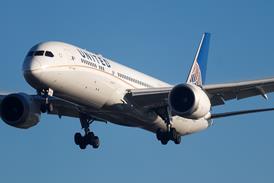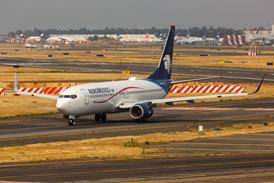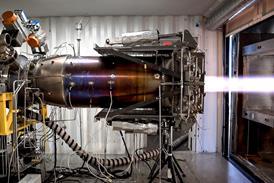
Max Kingsley-Jones/ISLE OF MAN Julian Moxon/NANTES Guy Norris/LOS ANGELES
Embraer spent a long time bringing its 50-seat RJ-145 to the marketplace. It was almost a full eight years from the original EMB-145 programme launch in June 1989 to service entry with launch customer Continental Express in April 1997, with the manufacturer having to negotiate a world economic slump, delayed privatisation and two major redesigns of the aircraft.
Despite these hurdles, the Brazilian manufacturer's efforts seem to have been worthwhile, with total sales of the regional jet now standing at some 180 aircraft, production rising to six a month and a new shorter fuselage 37-seat model, the ERJ-135, in development. Firm sales of the smaller model have now pased 70, with service entry scheduled for the second half of 1999.
As president of Continental Express, which is the largest as well as the launch airline customer for the aircraft, it may not seem surprising that David Siegel is an effusive enthusiast of the Brazilian regional jet. "We've been extremely pleased with the aircraft, although it's fair to say we've had our fair share of launch customer's teething pains," he says.
In spite of several "issues", Siegel's love affair with the ERJ-145 is alive and well. "You almost want to wave a magic wand and change your whole fleet into -145s. It's led to at least a 30% boost in traffic wherever it's been introduced," he enthuses. The airline has just selected the ERJ-135 for its move into the 30-seat jet market as part of its plans for an all-jet fleet, and will introduce the 37-seater in July 1999.
The US Federal Aviation Administration certificated the ERJ-145 in December 1996, and deliveries to Continental Express began the same month. The airline put the type into service in April 1997 and the 23rd aircraft had just been delivered as Flight International closed for press. The airline has a further 27 aircraft on firm order and up to 150 on option. "We're taking them in groups of 25, and we won't be at the point where we have to make another decision until the autumn," Siegel says. Although nothing has yet been firmly decided, he adds: "Judging by operational performance and the overwhelmingly positive customer reaction, it is extremely likely we'll buy more."

TRAINING ACCIDENT
It has not all been plain sailing, however. One ERJ-145 was written off in a training accident in February, caused by a "series of random events" says Siegel. "FlightSafety was supposed to deliver a simulator to us in June last year, which they didn't. The first simulator did not get certificated until a couple of weeks before the accident, so crews were still practising high risk manoeuvres in the real aircraft. We're just happy the simulators are on line now," he adds.
The bulk of operational issues cropped up within the first three months of operations, according to Siegel. "We spent some time waiting for revisions to the flight manuals, particularly for a change in the flap settings which we needed to take off from the commuter runway at Newark," he says. This is one of the three hubs, along with Houston in Texas and Cleveland in Ohio, from where the Continental ERJ-145s are operated. "Other revisions concerned changes to increase the amount of fuel we could carry on the aircraft and some changes to the power settings involving a revision to the FADEC [full authority digital engine control].
"We are waiting for new engines with better hot and high performance, and for the long range [LR] version for markets in Amarillo and Lubbock, Texas, as well as new markets in Mexico," Siegel adds. Aircraft number 23 is the first -145LR, all previous aircraft being extended range (ER) variants. The ERs are powered by the AE3007-A1, while the LRs are equipped with the higher rated -A3. "We don't need LRs across the whole fleet, so we will aim to have a 50:50 mix of ERs and LRs," he says, adding that all remaining aircraft on firm order are LRs.
The previous aircraft, number 22, was also the first to be introduced with a modified door which allows the ERJ-145 to be connected directly to a standard jetway. "It allows us to drop the use of the gangplank Flight-X device which we have used to connect to the jetways, but we think is sub-optimal," Siegel says. The new door design "-goes along the fuselage like the cargo door", he adds, instead of dropping down to provide an airstair. All previously delivered aircraft will be retrofitted with the revised design.
In support terms, "-Embraer has done a tremendous job. We've been pleasantly surprised as they've done as well, or better, than any other OEM [original equipment manufacturer]. But you can't compare them to Rolls-Royce [parent of Allison Engine] - they're in a category we've never seen before," says Siegel. The engine maker has had to deal with the issue of replacing some of the number 4 bearings in the AE3007 after a batch was discovered to have been badly manufactured by a supplier. "We still have some engines with that bearing, and we're in the process of changing them all out," he says.
Aircraft reliability is running at "98% in terms of maintenance reliability", he says, adding that the target is 99%, so "-we are a full point off where we want to be".
While Continental Express pioneered ERJ-145 operations in North America in April 1997, services with the 50-seater in Europe began about three months later with Regional Airlines, of Nantes, France, and Lisbon-based Portugalia. Rio Sul inaugurated ERJ-145 operations in South America last August.
Deliveries to European customers were held up by a delay in the certification of the aircraft by the Joint Aviation Authorities, which was finally received in May 1997, around six months later than originally planned. The delay was attributed to JAA modification requirements as well as difficulties in maintaining effective communications between its 22 member states. Embraer says that the modifications resulted from the JAA's "different interpretation" of airworthiness requirements, compared with that of the US FAA. Some European customers believe that problems stemmed from the fact that Embraer set out with US approval as the prime focus for the aircraft during its development.
To gain JAA approval, Embraer had to reduce maximum rudder deflection by 5° to 10°, because of concerns that the aircraft could gradually run out of aileron control at high rudder deflections. Changes were also required to the design of the cockpit overhead panel, and the engine and auxiliary power unit start switches.
Regional Airlines, the first European airline customer to order the type in November 1994, has taken delivery of six of the 10 ERJ-145s on order, with the 50-seater replacing its fleet of similarly sized Saab 2000 turboprops.
The carrier is highly satisfied with the Embraer and particularly what technical manager Patrick Cereti calls the "very high" entry into service reliability. He repeats the oft-heard complaints about the fragility of the cabin interior and confirms the engine problems experienced by other operators, but adds that the manufacturer support has been "-really excellent - so fast, in fact,that the JAA is having real trouble keeping up".
RELIABLE DESPATCH
Daily despatch reliability in March averaged 98.74%, while the weekly and monthly figures were 98.66% and 98.98%, respectively. This is well above the 97.5% level which Cereti says is normal for a new aircraft in its first months of service. "We hit 99.32% in June 1997, the first month of operations," he adds. "We have had our problems, but the fact is that this is an aircraft which departs.
"The simple design is a great asset," says Cereti. "Our engineers enjoy working on it." Regional carries out its own 400h (A Check) and 4,000h (C check) maintenance at Rouen and Lyon, with the first C check due early next year. The aircraft are flown an average of 200h/month, or between 8h and 9h daily. Fuel consumption, averaging 1,216litres/h per aircraft is "very satisfactory around - the same as for the Saab 2000", says Cereti.
Regional was the first operator to suffer an in-flight shutdown of an engine, on 1 December, 1997, after failure of the number 4 midspan roller bearing, with a second shutdown implemented before take-off, thanks to the onboard diagnostics system. This was followed soon after by shutdowns on aircraft operated by other airlines, whereupon an "AE3007 Upgrade Team" was formed by Allison and Rolls-Royce "-who have taken this very seriously", says Cereti. The team identified the culprit as substandard bearings. Alternative bearings produced by France's SNFA had no problems and are not subject to replacement. Engines equipped with the substandard bearings are being replaced gradually over an 18-month period, throughout the fleet, a process which began in April.
Other engine problems include premature wear on oil sump carbon seals, accounting for 60% of engine removals, and cracking of the torque tube which operates the high-pressure compressor stators. A strengthened version is to be introduced.
The latest 6.2-standard software for the Lucas FADEC, which was certificated in early April, has not met expectations and Cereti says: "We're now back to the previous 5.1 standard." Allison says the 6.2 software will be reissued soon. The excessive time taken to certificate the modifications called for by service bulletins is a major cause of concern - and for Regional Airlines it centres on the JAA's inherent slowness, leading from its multi-national structure, which allows for any one member country to block a modification if it needs more time to establish that it meets national safety requirements. An example is the introduction of a new operating procedure for descent in icing conditions, established during Embraer's post- certification flight testing. This calls for the deployment of the speedbrake with flaps set at 9° at speeds under 100kt (185km/h). It has yet to be approved by the JAA, although both the Brazilian authorities and the US FAA have cleared it.
US company C&D Aerospace, which manufactures the cabin, has introduced no fewer than 31 service bulletins relating to improvements to the interior, which, according to Cereti, was "-designed to be as light as possible to save aircraft weight". Many of the seat mechanism components, for example, were made from aluminium alloy, which has proved to be too weak for applications such as the seat reclining mechanism. They are being replaced by steel items.
The air conditioning system is to be totally replaced during C checks because it distributes warm air to the front of the cabin and cold air to the back. Modifications are also in hand to reduce noise from the system in seat rows 7 and 8.
Embraer has also responded to the complaint that Regional's first aircraft suffered high internal noise from the engines, introducing a specific noise mitigation programme resulting in a 3dB reduction. Cereti says that this has made the aircraft interior "one of the quietest in the business".
Several automated functions in the "dark cockpit" have been returned to manual, including windshield de-icing (because of temperature control problems) and the de-icing procedure at take-off. "It is regrettable," says Cereti, "because the lower the workload, the better it is for the pilot." He applauds, however, the lack of false warnings on the Honeywell electronic flight instrumentation system.

BA LOGO
Embraer was the first small regional jet manufacturer to put the British Airways logo on its customer list, when it secured an order from BA franchise operator British Regional Airlines (BRAL) in February 1997. The Manx Airlines' associate placed an initial contract for five aircraft, plus two options, which has since been increased to 15 firm orders and five options. Deliveries began in June 1997 and the first revenue service was flown on 18 August.
The selection of the type over the rival Bombardier Canadair Regional Jet (CRJ) and Saab 2000 came after a long evaluation process, says BRAL/Manx managing director Terry Liddiard. "Our comparisons with the CRJ revealed that the Embraer has considerably lower DOCs [direct operating costs], to the tune of 10%," he says, adding that the Saab 2000 was rejected "-simply because it has propellers, and we are seeking to improve passenger appeal with the new fleet".
The ERJ-145s are used exclusively on BRAL's BA franchise routes from Manchester and Southampton, replacing its smaller Jetstream 41s on certain sectors, which has seen bookings up by 40-60% because of the "jet factor", says Liddiard. "The aircraft has also enabled us to introduce new longer routes," he adds, pointing to Manchester-Berlin as an example. This route had previously been flown by BA itself, but was dropped because of environmental issues.
BRAL now has five 49-seat ERJ-145s in service, and its next batch of five will be delivered between October this year and May 1999. Liddiard says that the smaller ERJ-135 can be included among the options, but that en route and landing fees discourages the acquisition of smaller aircraft in Europe.
The airline's engineering and operations managers are full of praise for their new jet's overall performance and reliability. They believe that it is much further along its development path than were other aircraft at the same stage of introduction into service. "Embraer has delivered a very well thought-out aircraft - built for maintenance," says BRAL engineering and powerplant development manager Ron Church. "Service support and back-up is also very mature," he adds.
Liddiard says that there have been issues over the supply of spares, mainly because Embraer's own suppliers have been struggling to keep up with the combination of spares requirements and rapidly accelerating production demands. Spares are now pooled at centres in Brazil, Fort Lauderdale in Florida, and Paris, France. Embraer is working to build up its Paris spares stock and has reached about 60% of its $18 million target, says Liddiard. Church adds that the high demand for new aircraft has meant that certain spares have to be ordered from suppliers well in advance to guarantee availability.
Most of BRAL's crews have been transferred from its turboprop fleets, with some pilots having no previous jet experience moving up from the 29-seat J41. Although the ERJ-145's handling qualities are described as "docile" by BRAL operations director Norman Brewitt, the airline's turboprop pilots were checked out on a Boeing 727 simulator to assess their aptitude for jets before being streamed for conversion.
Turboprop pilots have found the transition fairly straightforward, and the similarity of the Honeywell Primus 1000 electronic flight instrument system to those in the J41 has helped. "The higher performance of the jet means you have to keep well 'ahead of the game'-everything happens a lot faster between nought and 10,000ft [3,500m]," says one pilot, talking about the switch to the ERJ-145. Another pilot, accustomed to having to step-climb larger jet aircraft at their maximum weights, is impressed by the ERJ-145's ability to climb with a full load of passengers and fuel straight to the maximum altitude of 37,000ft.
The aircraft's cruise performance has been as good as, or better than, promised, with a maximum operating speed of Mach 0.78, greater than first expected. Brewitt says that, at a typical cruise speed of 440kt/M0.76 at 35,000ft, total fuel flow is about 1,000-1,100kg/h. The aircraft typically crosses the threshold (Vref) at about 124kt, and touches down at about 117kt.
Unlike some operators, BRAL did not take its aircraft equipped with the Hurel Dubois-developed thrust reversers. "We don't really need them for our operations, and they would add unnecessary extra weight [130kg per engine] and complexity," says Brewitt.
BRAL's operations were initially restricted by the JAA's requirements to reduce rudder deflection by 5°. "This affected the Vmcg [minimum control speed on the ground], and in turn increased V1 [decision speed], restricting field performance from short runways such as Southampton," says Brewitt. "Embraer quickly developed a modification which provides us with 15° of rudder travel on the ground [through undercarriage microswitches], and the JAA's required 10¼ once airborne," he says.
Embraer is also developing an intermediate18° take-off flap setting as an alternative to the 9° and 24° already available. BRAL says that the new flap setting should boost the aircraft's payload performance, which has been "significantly lower than originally promised".

JAA FRUSTRATION
The new flap setting typifies Embraer's enthusiasm to support and develop the aircraft, says Brewitt, but he echoes Regional's frustrations that the JAA has struggled to keep pace with the manufacturer's developments. This, and the delays in the certification process, are partly attributed to the cultural differences between the European authorities and the South American manufacturer.
Other niggles suffered by BRAL have been minor. There was a spate of false engine oil pressure and temperature warnings (one of which nearly led to an engine shut-down) because of faulty connectors on the wiring. Brake temperature sensors have also been unreliable. Like Regional, BRAL has been disappointed with the cabin interior's lack of robustness. Some trim items, such as the overhead locker lids, have been replaced after breakages, says BRAL, while Regional says that the sliding door to the toilet has proved too weak, and is prone to jamming if passengers force it by attempting to push it open as if it were hinged. This has also necessitated new larger operating instruction notices for the lavatory door after a passenger on another airline apparently became trapped in the toilet after using the wrong opening technique and it became jammed.
Despite the various teething problems, the airlines are generally satisfied with their new jet's first working year. "Four years ago, this was a paper aircraft," says Regional's Cereti. "A lot of people didn't believe Embraer would succeed in putting it into the marketplace. The fact is that they did succeed. Globally, this is a good aircraft. We think Embraer has a lot to gain from developing the range, and we will be watching what they do very closely."
Source: Flight International




















